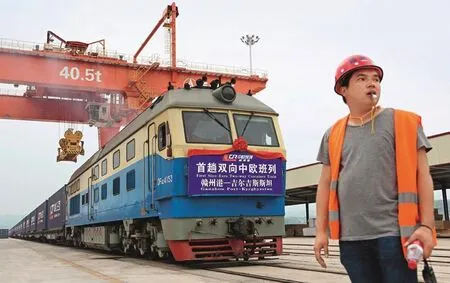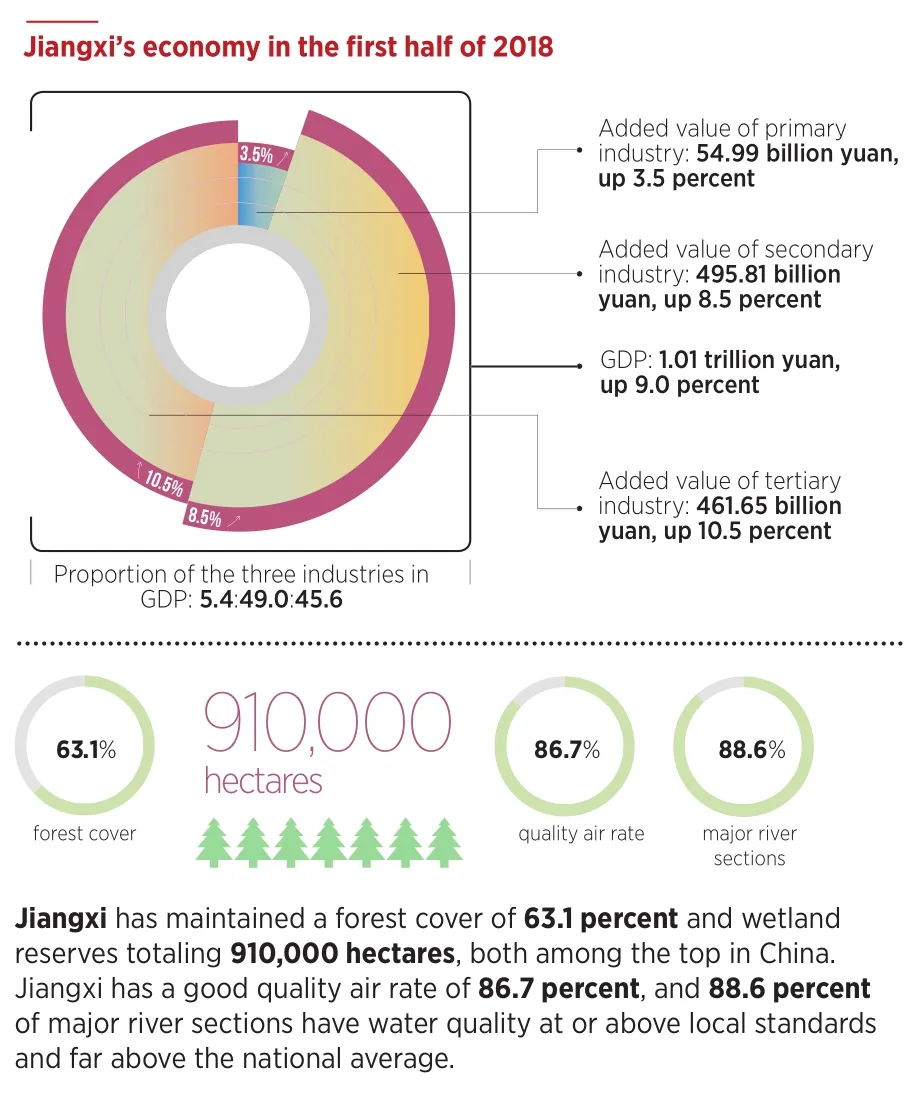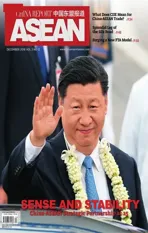JIANGXI:FULL SPEED AHEAD WITH REFORM
2018-12-25ByJiangXuan
By Jiang Xuan
Jiangxi Province in central China is an old revolutionary base area and the cradle of the Chinese revolution. Like a museum without walls of the history of the Chinese revolution, it showcases the tough journey Chinese communists had endured to found the People’s Republic of China. Before the Spring Festival in 2016,Chinese President Xi Jinping visited Jiangxi. After ascending Jinggangshan Mountains to visit the former residence of Mao Zedong, he exhorted the entire Communist Party of China (CPC)to stay true to their original aspirations along its journey towards greater success.
Like other places across China, Jiangxi has been following guidelines of reform and creating development miracles over the past 40 years since the adoption of the reform and opening-up policy.
Lifestyle Changes
Bayi Square is a landmark of Nanchang, capital of Jiangxi.Over the past half century, the square has been a key site for political, economic and cultural activities. In commemoration of the 50th anniversary of Nanchang Uprising,
construction on a memorial tower in the square started in 1977. From 2001 to 2004, largescale expansion and renovation projects were carried out which transformed the square into a modern memorial landmark with multiple functions including public recreation.
To mark the 90th anniversary of Nanchang Uprising and the founding of the People’s Liberation Army, Nanchang decided to further upgrade and renovate the square to make it a new urban landmark worthy of serving as the soul of this city of heroes.
The changes in Bayi Square over the last 40 years are not only cosmetic—lifestyles have evolved by leaps and bounds, too.
“Bayi Square was a recreational destination in the early 1980s,” recalled local resident Zou Li. “At dusk in summer, it became bustling with people sitting on mats on the lawn to escape the smothering heat.” Now it has evolved into an indispensable part of Nanchang as a destination integrating cultural events, commerce,recreation and hospitality.
Targeted Poverty Reduction
After 40 years of reform and opening-up, and in particular since the 18th CPC National Congress, China has seen the basic needs of over a billion people met, and has made it possible at basic levels for people to live decent lives. How to lift people out of poverty as quickly as possible has become one of the top priorities on the work agenda of the government and the CPC.
On February 26, 2017,Jinggangshan City, in southwestern Jiangxi,announced its success in taking the lead in the country to shake off poverty after passing an evaluation by the State Council Leading Group Office of Poverty Alleviation and Development and receiving approval from the provincial government of Jiangxi.
Jinggangshan highlighted targeted poverty alleviation measures in four key areas:developing industries,providing social security support, improving housing conditions and strengthening infrastructure. Local governments greatly supported efforts to develop industries that would employ rural workers.Those who were unable to work were encouraged to buy into agribusiness with capital or use land rights to gain stable asset returns. Social security programs were also made available for the permanently disabled to help them escape poverty.
“Last year, with the help of village officials, I learned about the revolutionary history of Jinggangshan and heard stories of people coming out of poverty,”said Zhu Qiufang, a 43-year-old woman who had struggled with poverty. “I learned valuable skills in planting yellow peaches,including grafting, fertilization and orchard management.”With a substantially increased income, her living standards have improved significantly.
Thanks to targeted poverty reduction measures like supports in healthcare and education, Zhu’s whole family was lifted out of poverty. According to the local government, the city rolled out incentives like a scorecard to reinforce achievements in poverty eradication. It also continued support for industry development, migrant workers and entrepreneurship.
New Historic Glory
“On the historic occasio n of the 40th anniversary of reform and opening-up, we should ponder how to aim high,look far and actively explore solutions to new issues of this new era with a more open mind and a broader vision,” exhorted Liu Qi, secretary of the Jiangxi CPC Provincial Committee.“How can we better understand the overall situation and trends to explore a more pragmatic path for high-quality and leapfrog development? How can we attain new glory by lifting 46 million people out of poverty on this land where great contributions and sacrifices were made to the Chinese revolution through greater action and a stronger sense of mission? These questions of the era—questions of responsibility, questions of original aspirations and questions of mission—must be properly answered.”
When Ganjiang New Area was approved by the State Council, Jiangxi became home to China’s 18th and central China’s second state-level new area to test out economic and administrative reform measures. The province also rolled out measures to reduce business costs and improve the business climate.A passenger-dedicated railway connecting Ganzhou in Jiangxi and Shenzhen in Guangdong Province is now under construction. A highspeed railway is about to bisect the province from north to south. Ganzhou now sees China-Europe freight trains going both ways. As a pioneer of implementing the Belt and Road Initiative, landlocked Jiangxi is becoming more and more open.
Innovative thinking has been highly influential on its development.

A clear day in Nanchang on June 25, 2018, after several days of rain.

Local women attend a free training class on how to prepare meals for new moms in Suichuan County,Jiangxi Province, on July 30. The training program empowers women, especially those facing employment difficulties, to work as well-paid maternity nurses.

A piece of fuselage of the Chinese passenger aircraft C919 rolls off the production line at Jiangxi Hongdu Aviation Industry Group Company on May 15, symbolizing the completion and delivery of every part of China’s homegrown passenger aircraft.

A high-speed train passes through Wuyuan County in Jiangsu Province on June 28, 2015.
Due to a shortage of wood,Nankang District in Ganzhou imports 75 percent of its timber from Southeast Asia, Africa and North America to meet the demand of local furniture makers. Due to several transfer requirements, the transport process was costly and timeconsuming. Can a coastal port be moved to landlocked Jiangxi? Nankang District has transformed this wild concept into reality. By taking advantage of construction and operation of Ganzhou port,it successfully upgraded its furniture sector. As the only timber-importing port, and the f rst inland pilot zone under direct administration of the General Administration of Quality Supervision Inspection and Quarantine and the eighth temporary inland port for foreign trade approved by the State Council, Ganzhou railway port is injecting robust vitality to Jianxi’s development.
Since the 18th CPC National Congress, the growth rates of Jiangxi’s major economic indicators have been maintained among the f rst phalanx of provinces spearheading the national economy. Its GDP ranking among Chinese provinciallevel regions has risen.Industries with output over 100 billion yuan (US$14.4 billion) increased fromfive to 11, covering textiles, building materials, pharmaceuticals,autos and electronic information sectors. The added value of high-tech industries accounted for 31.7 percent of the total for industries above a designated scale. Services sectors contributed for 42.3 percent of provincial GDP growth.
Statistics show that Jiangxi’s provincial GDP hit 2.08 trillion yuan (US$299.5 billion) in 2017,up 8.9 percent year on year.

Per capita GDP was 45,187 yuan (US$6.507) , an increase of 8.2 percent from the previous year.
Capitalizing on Green Resources
Over recent years, Jiangxi has remained committed to advancing the economy in tandem with ecological conservation, exploring a unique path for green development with Jiangxi characteristics. In 2014, the province was included among thefirst national demonstration regions for ecological advancement. Boasting China’s largest freshwater lake and over 3,700 rivers each with a drainage area of more than 10 square kilometers, Jiangxi highlighted the strategic position of ecological advancement and took the lead in implementing ecological compensation policy across the watershed regions.
Jiangxi considers institutional innovation the core task for building a national pilot zone for ecological advancement. A system featuring tight control over the source, strict management of the process and harsh punishment for offenders has taken shape. Measures include setting up a red line for ecological conservation, introducing an upgraded version of the river chiefs system and implementing ecological compensation policies in the watersheds of Poyang Lake andfive major rivers.
“People who protect the environment will be rewarded, whereas anyone who pollutes it will pay for the damage.” As a forerunner in implementing ecological compensation policy, Jiangxi devised a solution to balancing the interests of various parties.The policy covers all 100 counties and the many cities and districts in the province.Despite it dealing with a shortage of public funds,Jiangxi has raised money from various channels and earmarked funds of 2.09 billion yuan (US$300 million) for ecological compensation.
Jiangxi has also improved the evaluation system for scientific development at city and county levels so that performance in ecological advancement is considered a f rst-grade indicator weighing up to 19.35 percent from previous 16 percent in 2014.
At present, the evaluation system on ecological advancement in Jiangxi is also improving to include evaluation of scientific development, ecological advancement, inspection of environmental protection and auditing of natural resources as officials leave office. The province is now formulating a supportive accountability mechanism.
In sync with other provinces in the Yangtze River Economic Belt region for ecological conservation, Jiangxi has shut down many heavily polluting factories and coal mines over the years, including some 700 in Jiujiang. The move didn’t harm the economy, and in fact boosted it. In 2017, booming agro-tourism in the province created 680,000 jobs and helped 450,000 rural residents increase their incomes. Among them,100,000 impoverished people from 33,000 registered poor households escaped poverty.
